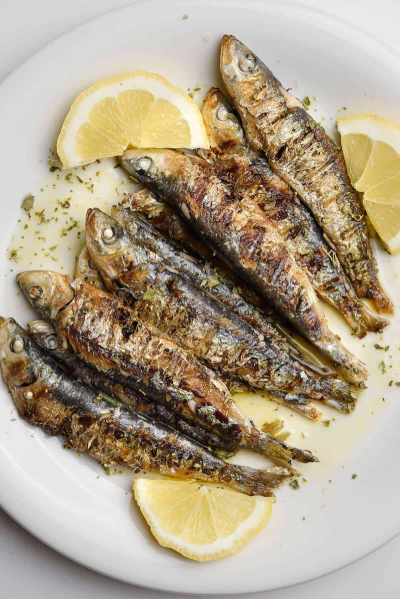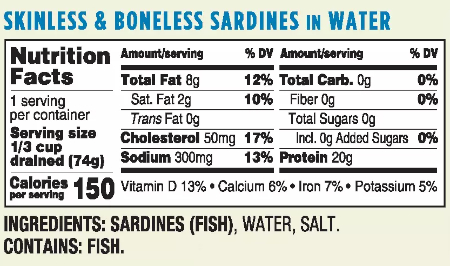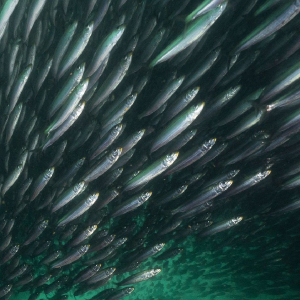I can’t think of any classic food that’s more beloved by some – and more despised by others. Sardines are an acquired taste. But one you should think about acquiring. Sardines are an amazing source of beneficial nutritional substances…

What they are
Sardines are small, silvery, oily fish found near the southern European shores of the Atlantic Ocean, and across the Mediterranean. They’re abundant all along the Pacific coasts of North and South America, as well as in Japan, Southeast Asia, Australia and South Africa. And all coats of the Indian Ocean.
They are marketed in a range of sizes from about 3.5 in. / 8.75 cm – the ones that come packed in oil or water in those little flat cans – to around 8 or 9 in. / 20 to 22.5 cm. The latter are prized for their flavour and texture, and play starring roles – grilled fresh – at Spanish and Portuguese Tapas bars.
Not everybody’s ‘cup of fish’
I remember the first time I was offered sardines – by a European émigré neighbour, when I was maybe 7 or 8 years old. I didn’t like the smell, right off. So I expected the flavour to be no less disturbing. I wasn’t disappointed. That one early, negative experience effected me so deeply that, even now, just hearing or reading the word ‘sardine’ can make me gag.
They say sardines are an acquired taste. But I’m as sure as the day is long that I’ll never acquire it.
That’s too bad…
… In a way. Because sardines turn out to be a treasure trove of nutritional goodies. Vitamins, minerals, protein, and bioactive substances such as Omega 3 fatty acids, anti-oxidants and polyphenols.
The label says:
According to the label on the can, Sardines have little or no nutritional value…

At least, not much of the bad stuff. If you don’t count Salt. But it’s a vastly different story if you look at the official rundown:
Complete Sardine nutrition facts:
One 3.75-ounce can (about 92 grams) of Atlantic sardines contains approximately:
- 191 calories
- 22.7 grams protein
- 10.5 grams fat
- 8.2 micrograms vitamin B12 (137 percent DV*)
- 48.5 micrograms selenium (69 percent DV)
- 250 international units vitamin D (63 percent DV)
- 451 milligrams phosphorus (45 percent DV)
- 351 milligrams calcium (35 percent DV)
- 4.8 milligrams niacin (24 percent DV)
- 2.7 milligrams iron (15 percent DV)
- 365 milligrams potassium (10 percent DV)
- 35.9 milligrams magnesium (9 percent DV)
- 0.2 milligrams copper (9 percent DV)
- 1.9 milligrams vitamin E (9 percent DV)
- 0.2 milligrams vitamin B6 (8 percent DV)
- 1.2 milligrams zinc (8 percent DV)
* DV = Recommended daily ‘dose’
Holy mackerel!
An appropriate choice of phrase, since sardines are, in fact, miniature cousins of the mackerel. But I digress…
DrAxe.com lists a host of enticing sardine benefits:
- High in anti-imflammatory Omega 3s
- Rich in essential vitamins and minerals
- High in B12, for your metabolism and nerve health
- High in anti-oxidant selenium
- High in calcium, phosphorus and D – for bone health
- Healthy fats and protein – help control blood sugar
- Help promote weight loss
- Low in mercury and other pollutants
How to eat them
The are those who condemn the use of sardines (or look-alike but less healthy anchovies) on Pizza. And there are also those who – as with sardines themselves – love them on The Pie. But there are myriad other ways to enjoy sardines:
- Put them in salads for a unique flavour zip.
- Make a sardine spread for snacks.
- Serve with salsa for dipping.
- Add to fish cakes for robust flavour.
- Partner them with marinated veggies.
- Add them to any seafood-themed dish.
- Pop a few into your next Tortilla (Spanish Omelet).
- Whip up a traditional Spanish or Sicilian Sardine Pasta.
- Try sardine, tomato and red onion Bruschetta.
Google yourself crazy! There are thousands of recipe ideas out there!…
My take
Sister Erin is a sardine addict. According to the grocery store receipt she just brought home, she paid (C)$4.50 for a single can! But she treats herself to the most expensive ones. I found a similar-sized can of No-Name sardines at my go-to supermarket’s online shopping site for just $1.79. And the most popular name brand was priced at a reasonable $2.79.
Tip: Make sure you buy sardines packed in water. Those packed in oil – per European tradition – are much fattier, and higher in Calories. And Erin says they taste ‘funny’, too…
I am forced to admit that I might actually like grilled fresh sardines – à la Tapas. But just try to find them in your local supermarket seafood department!
Bottom line:
If you can acquire the taste, you really should embrace healthy, versatile sardines!
~ Maggie J

